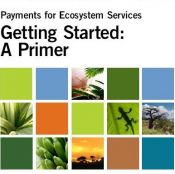Payments for Ecosystem Services: Download the Primer
Payments for Ecosystem Services encourage entities that benefit from ecosystem services to pay for maintaining those ecosystems – but how? At the Biodiversity Conference (COP 9) in Bonn, Germany, Forest Trends, the Katoomba Group and the United Nations Environment Programme (UNEP) have jointly unveiled a nuts-and-bolts primer designed to answer that question.

Payments for Ecosystem Services encourage entities that benefit from ecosystem services to pay for maintaining those ecosystems – but how? At the Biodiversity Conference (COP 9) in Bonn, Germany, Forest Trends, the Katoomba Group and the United Nations Environment Programme (UNEP) have jointly unveiled a nuts-and-bolts primer designed to answer that question.
21 May 2008 | Francis Ogwal has spent years trying to balance the opposing forces of economic development and environmental protection. Now, as focal point for the Convention on Biological Diversity (CDB) within Uganda’s National Environment Management Authority, he believes he’s found a tool that help him do just that.
“Payments for Ecosystem Services (PES) are still relatively new in Uganda, but there is growing interest in that approach, because we have been relying mainly on the old method of provision of money for conservation from government and donors,” he said at the ninth meeting of the Conference of the Parties (COP 9) to the CBD. “But there is a lot of competition for these resources, especially in developing countries – where you want to put money into education, health, and agriculture – and conservation always ends up way down on the list.”
New Resource for Rural Poor
He was speaking at a side event introducing Payments for Ecosystem Services Getting Started: a Primer, which is now available for download.
The 70-page document was compiled by theKatoomba Group (parent of the Ecosystem Marketplace), Forest Trends, and the United Nations Environment Programme (UNEP), with contributions from the Division of Environmental Law and Conventions (DELC), and funded through UNEP by the Norwegian Government.
It is designed as a resource for people in developing countries looking to implement such schemes in a way that not only preserves and promotes ecosystem services, but does so in a way that empowers the rural poor of the developing world as stewards of an ecosystem service, for which they can be justly compensated.
Four-Step Process
The document covers the challenges of structuring programs that both deliver environmental benefits and benefit the rural poor, and its core is a four-step process for establishing PES projects. The steps include:
• Identifying Ecosystem Service Prospects and Potential Buyers
• Assessing Institutional and Technical Capacity as well as Access
• Structuring Agreements
• Implementing PES Agreements
Each of these steps is broken down into smaller steps in an effort to introduce potential sellers of ecosystem services to the details of PES deals. Throughout the document, there are numerous case studies to illustrate components of the process.
Not a Panacea
The document makes it clear that PES is not a panacea. Among the obstacles highlighted: high transaction costs, a lack of regulatory drivers, and lack of understanding among those who can benefit the most from such schemes.
“People have to understand that PES schemes won’t lead to a windfall of money, and that you can’t just go out, plant trees, and hope to get rewarded,” said Rahweza. “This is a learning process, and we are simply trying to provide a resource that will help people along that process.”
Eva Haden agrees. Water and Ecosystems Program Officer for the World Business Council for Sustainable Development, she said that industry has a long to go before funding of PES schemes takes place on a level anywhere near that of the booming carbon markets.
“At this point, there is just too much uncertainty – even about basic definitions of what constitutes payment for an ecosystem service, or what constitutes an ecosystem service,” she said. “Documents like this go a long way towards moving beyond abstract theory and providing some sort of common definition, but we have a long way to go.”
Steve Zwick is managing editor of the Ecosystem Marketplace. He can be reached at [email protected].
Please see our Reprint Guidelines for details on republishing our articles.
Additional resources
Please see our Reprint Guidelines for details on republishing our articles.

